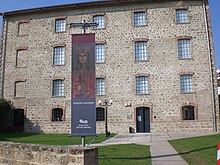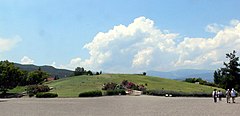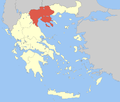| Revision as of 17:31, 2 March 2014 editCardofk (talk | contribs)Autopatrolled, Extended confirmed users, Rollbackers24,882 editsm Reverted 1 edit by 62.44.135.196 (talk) to last revision by Pjposullivan. (TW)← Previous edit | Revision as of 17:33, 2 March 2014 edit undo62.44.135.196 (talk) Undid revision 597833787 by Pjposullivan (talk) Other cities also have other langages for example Tetovo in Macedonia.Next edit → | ||
| Line 32: | Line 32: | ||
| }} | }} | ||
| '''Veria''' (officially transliterated as '''Veroia''', ] '''Βέροια''' or ''Βέρροια''), historically also spelled ''']''', is a city in northern ], located {{convert|511|km|0|abbr=off}} north-northwest of the capital ] and {{convert|73|km|0|abbr=on}} west-southwest of ]. | '''Veria''' (officially transliterated as '''Veroia''', ] '''Βέροια''' or ''Βέρροια'', {{lang-mk|Бер}}, ''Ber''), historically also spelled ''']''', is a city in northern ], located {{convert|511|km|0|abbr=off}} north-northwest of the capital ] and {{convert|73|km|0|abbr=on}} west-southwest of ]. | ||
| Even by the standards of Greece, Veria is an old city; first mentioned in the writings of ] in 432 BC, there is evidence that it was populated as early as 1,000 BC.<ref name="">veria.gr accessed June 1, 2008.</ref> Veria was an important possession for ] (father of ]) and later for the ]. ] famously preached in the city, and its inhabitants were among the first Christians in the Empire. Later, under the ] and ] empires, Veria was a center of Greek culture and learning. Today Veria is a commercial center of Central ], the capital of the ] of ] and the seat of a metropolitan bishop of the ] and the ]. | Even by the standards of Greece, Veria is an old city; first mentioned in the writings of ] in 432 BC, there is evidence that it was populated as early as 1,000 BC.<ref name="">veria.gr accessed June 1, 2008.</ref> Veria was an important possession for ] (father of ]) and later for the ]. ] famously preached in the city, and its inhabitants were among the first Christians in the Empire. Later, under the ] and ] empires, Veria was a center of Greek culture and learning. Today Veria is a commercial center of Central ], the capital of the ] of ] and the seat of a metropolitan bishop of the ] and the ]. | ||
Revision as of 17:33, 2 March 2014
For other uses of Veria and Beroea see Veria (disambiguation). Settlement in Greece| Veria / Veroia Βέροια | |
|---|---|
| Settlement | |
 Panoramic view Panoramic view | |
 Seal Seal | |
| Country | Greece |
| Administrative region | Central Macedonia |
| Regional unit | Imathia |
| Government | |
| • Mayor | Charoula Ousoultzoglou-Georgiadi |
| Elevation | 128 m (420 ft) |
| Population | |
| • Municipal unit | 48,306 |
| Time zone | UTC+2 (EET) |
| • Summer (DST) | UTC+3 (EEST) |
| Postal code | 591 00 |
| Area code(s) | 2331 |
| Vehicle registration | ΗΜ |
| Website | www.veria.gr |
Veria (officially transliterated as Veroia, Greek: Βέροια or Βέρροια, Template:Lang-mk, Ber), historically also spelled Berea, is a city in northern Greece, located 511 kilometres (318 miles) north-northwest of the capital Athens and 73 km (45 mi) west-southwest of Thessalonica.
Even by the standards of Greece, Veria is an old city; first mentioned in the writings of Thucydides in 432 BC, there is evidence that it was populated as early as 1,000 BC. Veria was an important possession for Philip II of Macedon (father of Alexander the Great) and later for the Romans. Apostle Paul famously preached in the city, and its inhabitants were among the first Christians in the Empire. Later, under the Byzantine and Ottoman empires, Veria was a center of Greek culture and learning. Today Veria is a commercial center of Central Macedonia, the capital of the regional unit of Imathia and the seat of a metropolitan bishop of the Ecumenical Patriarchate and the Church of Greece.
History




The city is reputed to have been named by its mythical creator Beres - Pheres or from the daughter of the king of Berroia who is the thought to be the son of Macedon. The Ancient Macedonians made it their second most important city after Pella. Part of the Kingdom of Macedon, it surrendered to Rome in 168. During the Roman empire, Veria became a place of worship for the Romans. Diocletian made the large and populous city one of two capitals of the Roman Province of Macedonia. Within the city there was a Jewish settlement where the Apostle Paul preached after leaving Thessalonica (Acts 17:10-15). The Apostle Paul and his companion Silas preached to the Jewish and Greek communities of the city in AD 50/51 or 54/55 (see Bereans). Said section provides:
'10 As soon as it was night, the brothers sent Paul and Silas away to Berea. On arriving there, they went to the Jewish synagogue. 11Now the Bereans were of more noble character than the Thessalonians, for they received the message with great eagerness and examined the Scriptures every day to see if what Paul said was true. 12Many of the Jews believed, as did also a number of prominent Greek women and many Greek men. 13 When the Jews in Thessalonica learned that Paul was preaching the word of God at Berea, they went there too, agitating the crowds and stirring them up. 14 The brothers immediately sent Paul to the coast, but Silas and Timothy stayed at Berea. 15 The men who escorted Paul brought him to Athens and then left with instructions for Silas and Timothy to join him as soon as possible."
Further information: Berea (Bible) and BereansUnder the Byzantine Empire the city continued to grow and prosper until it was attacked by the Normans (1185) and the Franks (1204) and in the middle of the 14th century by the Serbs. Invaded by Serbs and Bulgars, it was captured by the Ottomans in 1361, who named it Karaferye and established a military colony. In 1436, it was besieged and captured again by the Ottoman Empire and remained in their control until 1912. Veria was united with Greece on 16 October 1912 (Julian calendar) / 29 October 1912 (Gregorian calendar).
Geography
Geology
Veria is located at 40º31' North, 22º12' East, at the eastern foot of the Vermio Mountains. It lies on a plateau at the western edge of the Central Macedonia plain, north of the Haliacmon River. The town straddles the Tripotamos (river), a Haliacmon tributary that provides hydroelectric power to the national electric power transmission network and irrigation water to agricultural customers of the Veria plain.
Climate
Veria has a humid subtropical climate (Köppen climate classification Cfa) that borders on a cold semi-arid climate (Köppen climate classification BSk). Since the city lies in a transitional climatic zone, its climate displays characteristics of continental, semi-arid and subtropical/Mediterranean climates. Summers (from April to October) are hot (often exceptionally hot) and dry (or mildly humid, with rainfalls that occur during thunderstorms), and winters (from mid-October to March) are wet and cool, but temperatures remain above or well above freezing (meteorological phenomenon of Alkyonides). Snow typically falls once or twice a season. Major temperature swings between day and night are seldom.
| Climate data for Veria | |||||||||||||
|---|---|---|---|---|---|---|---|---|---|---|---|---|---|
| Month | Jan | Feb | Mar | Apr | May | Jun | Jul | Aug | Sep | Oct | Nov | Dec | Year |
| Record high °C (°F) | 21.0 (69.8) |
24.0 (75.2) |
25.4 (77.7) |
31.0 (87.8) |
35.0 (95.0) |
39.0 (102.2) |
41.0 (105.8) |
42.1 (107.8) |
35.9 (96.6) |
33.5 (92.3) |
27.0 (80.6) |
25.6 (78.1) |
42.1 (107.8) |
| Mean daily maximum °C (°F) | 9.1 (48.4) |
10.8 (51.4) |
14.5 (58.1) |
19.4 (66.9) |
25.1 (77.2) |
29.5 (85.1) |
31.3 (88.3) |
30.9 (87.6) |
27.8 (82.0) |
21.6 (70.9) |
14.3 (57.7) |
10.1 (50.2) |
20.4 (68.7) |
| Daily mean °C (°F) | 4.6 (40.3) |
5.9 (42.6) |
9.4 (48.9) |
14.1 (57.4) |
19.6 (67.3) |
24.1 (75.4) |
25.7 (78.3) |
24.7 (76.5) |
21.1 (70.0) |
15.6 (60.1) |
9.5 (49.1) |
5.7 (42.3) |
15.0 (59.0) |
| Mean daily minimum °C (°F) | 0.6 (33.1) |
1.4 (34.5) |
4.4 (39.9) |
8.2 (46.8) |
12.8 (55.0) |
16.3 (61.3) |
18.0 (64.4) |
17.3 (63.1) |
14.1 (57.4) |
9.9 (49.8) |
5.3 (41.5) |
1.8 (35.2) |
9.2 (48.5) |
| Record low °C (°F) | −12.0 (10.4) |
−11.0 (12.2) |
−4.0 (24.8) |
4.0 (39.2) |
7.7 (45.9) |
14.6 (58.3) |
14.3 (57.7) |
13.5 (56.3) |
7.1 (44.8) |
1.1 (34.0) |
−3 (27) |
−5 (23) |
−12.0 (10.4) |
| Average precipitation mm (inches) | 44.5 (1.75) |
49.0 (1.93) |
56.4 (2.22) |
45.0 (1.77) |
42.0 (1.65) |
29.7 (1.17) |
14.1 (0.56) |
16.2 (0.64) |
16.1 (0.63) |
55.7 (2.19) |
68.1 (2.68) |
69.1 (2.72) |
505.9 (19.91) |
| Average precipitation days | 8.2 | 9.1 | 9.5 | 8.6 | 8.6 | 5.1 | 3.9 | 3.5 | 3.6 | 7.5 | 9.9 | 9.2 | 86.7 |
| Average relative humidity (%) | 76.4 | 73.0 | 73.2 | 68.3 | 64.2 | 57.9 | 57.5 | 62.8 | 66.8 | 73.1 | 77.1 | 78.2 | 69.0 |
| Mean monthly sunshine hours | 117.1 | 120.4 | 143.8 | 190.4 | 234.9 | 295.3 | 309.6 | 290.6 | 224.9 | 162.1 | 118.3 | 109.1 | 2,316.5 |
| Source: Hellenic National Meteorological Service, National Observatory of Athens | |||||||||||||
Economy

The modern town has cotton and woolen mills and trades in wheat, fruit, and vegetables. Lignite mines operate in the area. The largest wind farm in Greece is to be constructed in the Vermio Mountains by Acciona, S.A.. It will consist of 174 wind turbines, which will be connected to the national electric power transmission network, generating 614 MW.
Infrastructure - Transport
Veria is linked to Thessalonica by the Thessalonica-Edessa railway, with connections to Athens and Alexandroupoli. Veria is connected to the motorway system of Greece and Europe through Egnatia Odos, the Greek part of the European route E90. It is also connected to more than 500 local and national destinations via the national coach network (KTEL). Thessalonica International Airport "Macedonia" is the closest international airport, located 88 km (55 mi) east-northeast of Veria.
Education
Veria has one of the largest public libraries in Greece. Originally a small single-room library with limited funds and material, it expanded into a four-story building offering multimedia, as well as special and rare editions. Veria's public library collaborates with many international organizations and hosts several cultural events.
The Department of Spatial Planning and Development Engineering of Aristotle University of Thessaloniki is located in Veria since 2004.
Culture
UNESCO World Heritage Site| UNESCO World Heritage Site | |
|---|---|
 | |
| Criteria | Cultural: i, iii |
| Reference | 780 |
| Inscription | 1996 (20th Session) |
Museums in Veria include the Archaeological Museum of Veroia, the Byzantine Museum of Veroia, a museum of modern Greek history and a laographical museum. There are also 48 Byzantine and post-Byzantine churches, four Ottoman mosques, and a 19th-century Jewish synagogue in the protected Jewish neighbourhood.
The Archaeological Site of Aegae / Aigai (Greek Αἰγαί; modern name Vergina), a UNESCO World Heritage Site, lies 12 km (7 mi) south-east of the city centre of Veria.
Every summer (August 15 to September 15) the "Imathiotika" festivities take place with a rich cultural program deriving mainly from Veria's tradition. The site of Elia offers great natural beauty and with an amazing view of the Imathia plain. Neighboring Seli is a well-known ski resort and a few kilometers outside the city is the Aliakmonas river dam.
Local government – Municipality
The municipality Veria was formed at the 2011 local government reform by the merger of the following 5 former municipalities, that became municipal units:
Twin towns — sister cities
See also: List of twin towns and sister cities in GreeceVeria is twinned with:
Sports
Veria is home to many sports clubs. Most prominent is the handball team of Filippos Veria, competing in the first national division and which has won many championships (both national and international) over the last 40 years. The most famous is Veria FC which competes in Alpha Ethniki (Greece's 1st division). Veria also has two basketball teams, AOK Veria and Filippos Veria, which compete in the local and third national division respectively.
Notable people

- Demetrius Vikelas, Greek writer; the first president of the International Olympic Committee (IOC)
- Konstantinos Raktivan, liberal politician, lawyer, Greek Council of State's first president, member of the Academy of Athens, speaker of the Hellenic Parliament
- Ioannes Kottounios, Renaissance humanist and philosopher
- Konstantinos Kallokratos, teacher and poet
- Sopater, kinsman of Paul
- Patriarch Metrophanes of Alexandria, Patriarch of Alexandria
- Patriarch Nephon I of Constantinople, Ecumenical Patriarch (Constantinople)
- Sonia Theodoridou, Greek soprano
- Efthymios Warlamis, Greek architect, sculptor and painter
- Sedat Alp, Turkish archaeologist
- Michalis Chrisochoidis, Greek politician
- Mimis Papaioannou, Greek football player
- Kostas Tsartsaris, Greek professional basketball player
- Yiannis Arabatzis, footballer
- Pantelis Kafes, footballer
- Panagiotis Tsalouchidis, former football player
- Pavlos Kontogiannidis, actor, singer
- Dimitris Mavropoulos, actor and theatrical director
Gallery
-
 St. Paul preaching
St. Paul preaching
-
Metrophanes Kritopoulos (1589 – 1639); Greek Macedonian theologian and Patriarch of Alexandria from Veria
-
 Old postcard with the clock tower of the city (c. 1916)
Old postcard with the clock tower of the city (c. 1916)
-
Traditional dress
-
 Archaeological Museum of Veroia
Archaeological Museum of Veroia
-
 Hamam
Hamam
-
 View of Barabuta, Jewish quarter
View of Barabuta, Jewish quarter
-
 Church of the Resurrection of Christ interior
Church of the Resurrection of Christ interior
-
 Metropolis
Metropolis
-
 Veria Stadium
Veria Stadium
-
Panoramic view
-
River across the city
-
View of Thessalonikis street on a snowy day
See also
References
- "Απογραφή Πληθυσμού - Κατοικιών 2011. ΜΟΝΙΜΟΣ Πληθυσμός" (in Greek). Hellenic Statistical Authority.
- veria.gr Veria:Its history (greek) accessed June 1, 2008.
- (greek) hellasportal.gr,Apostle Paul preach in Veria, accessed June 1, 2008.
- Kallikratis law Greece Ministry of Interior Template:El icon
- ^ "Twinnings" (PDF). Central Union of Municipalities & Communities of Greece. Retrieved 2013-08-25.
- Merry, Bruce (2004). Encyclopedia of modern Greek literature. Greenwood Publishing Group. p. 239. ISBN 0-313-30813-6.
KOTTOUNIOS, IOANNES (1577-1658) Born at Beroia (Macedonia)
External links
| Administrative division of the Central Macedonia Region | ||
|---|---|---|
| ||
| Regional unit of Chalkidiki |  | |
| Regional unit of Imathia | ||
| Regional unit of Kilkis | ||
| Regional unit of Pella | ||
| Regional unit of Pieria | ||
| Regional unit of Serres | ||
| Regional unit of Thessaloniki | ||
| ||
| Subdivisions of the municipality of Veria | |
|---|---|
| Municipal unit of Apostolos Pavlos |
|
| Municipal unit of Dovras |
|
| Municipal unit of Makedonida |
|
| Municipal unit of Vergina | |
| Municipal unit of Veria |
|
| Journeys of Paul the Apostle | |
|---|---|
| First journey | |
| Second journey | |
| Third journey | |
